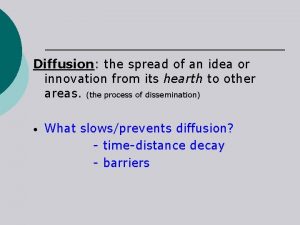Diffusion the spread of an idea or innovation































- Slides: 31

Diffusion: the spread of an idea or innovation from its hearth to other areas. (the process of dissemination) • What slows/prevents diffusion? - time-distance decay - barriers

Barriers to diffusion ¡ Physical barriers in nature: l ¡ rivers, oceans, lakes, and mountain ranges. Cultural: l l religious beliefs. language ¡ Political: a boundary/type of govt. can impede or slow the spread of “something”. ¡ Economic factors – l people in certain places can’t afford to purchase a new commodity or technological innovation.

2 Types of Diffusion 1 - Expansion Diffusion: an idea or innovation that spreads outward from the hearth ¡ *There are 3 sub-forms: • Contagious – spreads adjacently/everywhere • Hierarchical – spreads to specific people/places, not everywhere (selective) • Stimulus – idea promotes a change before people do/accept things.


Stimulus Diffusion Because Hindus believe cows are holy, cows often roam the streets in villages and towns. The Mc. Donalds restaurants in India feature veggie burgers.

¡ Contagious diffusion l Places near the origin are affected first

Hierarchical diffusion --- A phenomenon begins in one place (often a large urban center), and then moves to another large center, and another, until it moves to smaller centers. Hierarchical effects occur when phenomena spread first to major cities, then to intermediate-size places, and later to small towns and rural areas (Figure 3. 3 b).

2 - Relocation diffusion People move to a new area and take their language, religion, and other cultural items with them. ¡ The items being diffused typically leave the original areas behind as they move to new areas. ¡ Example: Black Americans who moved from the rural South to the urban North during the mid-20 th century brought Blues music to Chicago.

Examples of Diffusion ¡ Religions ¡ Food ¡ Cultural trends - Music ¡ Plants/Animals/Insects ¡ Diseases *You should be able to apply the type(s) of diffusion to the following slides/examples

Worldwide, there are 1. 4 billion followers of Islam There are between 5 – 7 million Muslims in the United States Diffusion of Islam 630 – 1600 AD

Starbucks. . They're everywhere

Diffusion or (in this case) Fusion of Food ¡ In China, the chief food flavor used is soy ¡ In India, the principal flavoring is curry ¡ Both spices spread or ‘migrated’ ¡ As a result, Thai food, influenced by both China and India, is a blend of both cuisines, yet uniquely Thai

Music, clothing and fads ¡ New clothing & music fads spread quickly among major world cities such as ? ____ ¡ Only later do they filter down the urban hierarchy

Plants, Animals & Insects ¡ Arizona is a case study= ‘introduction of alien plant species’ due to migration of people from all over US to Arizona ¡ Kudzu – from Japan ¡ West Nile Virus ¡ Africanized Killer Bees

• Kudzu resembles soybeans or cowpeas. Kudzu • Its roots can reach a depth of 8 feet and have a circumference of over three inches. ¡ ¡ ¡ Roots are jointed & often branch every two or four feet and can form separate, independent plants as the root joints die. One of the fastest growing plants around, with the ability to expand as much as 60 feet in one season! It’s very difficult to control. It has taken over some areas of the US, such as Louisiana and Mississippi.

West Nile Virus

Distribution of West Nile Virus: Humans, Birds, & Mosquitos, 2001


West Nile Virus Cases in Arizona

Africanized (Killer) Bees

Diffusion of Africanized Bees after their arrival to Brazil, South America

Africanized Bees travel through Mexico throughout the 1990 s

Killer Bees in the United States

Where did AIDS come from & how did it get here? ¡ 2 strains from east and west Africa were identified in the early 1980 s ¡ Similar to strain of SIV (found in wild monkey populations) ¡ Earliest documented case was a man in Kinshasa, Congo, 1959 ¡ Researchers believe over time SIV evolved into HIV through a process called ‘zoonosis’ (perhaps by butchering & consuming monkeys)

¡ From origins in Africa, the virus diffused to other parts of the world as infected people (unknowingly) migrated out, or travelers to Africa contracted the virus and carried it home… ¡ Haiti in the Caribbean – with African cultural heritage and connections was one of the first countries in the western hemisphere where AIDS was found The Path of AIDS…

Patient Zero ¡ ¡ HIV in the US is believed to have originated from a flight attendant who vacationed in Haiti’s capital, Port-au. Prince In 1981, the sexual contacts of 40 men revealed that 8 had direct contact with Patient Zero, and many others indirectly


¡ Access to AIDS drugs differs in the developed world vs the developing world ¡ AIDS has become a worldwide pandemic Diffusion of AIDS


AIDS in the US & Sub-Saharan Africa ¡ In the US l Homosexual males & intravenous drug users were among those most commonly affected l Now, AIDS cuts across all sociological boundaries (age, gender, sexual orientation, race…) ¡ In sub-Saharan Africa l HIV/AIDS primarily affects young women (4 times as high as the rate for men) ¡ l For women, AIDS progresses faster, and they die sooner This greatly alters African society

 Swabt
Swabt What is expansion diffusion
What is expansion diffusion Diffusion of innovation in consumer behaviour
Diffusion of innovation in consumer behaviour Hvad er invention
Hvad er invention Innovation diffusion theory
Innovation diffusion theory Diffusion of innovation theory ppt
Diffusion of innovation theory ppt Incremental innovation vs disruptive innovation
Incremental innovation vs disruptive innovation Mysite.socccd
Mysite.socccd Contoh controlling idea
Contoh controlling idea Penanda wacana dalam penulisan akademik
Penanda wacana dalam penulisan akademik Is the main idea the theme
Is the main idea the theme Find the main idea of a paragraph
Find the main idea of a paragraph What is minor support sentence
What is minor support sentence Homiletical idea
Homiletical idea Stated main idea
Stated main idea Lời thề hippocrates
Lời thề hippocrates Vẽ hình chiếu đứng bằng cạnh của vật thể
Vẽ hình chiếu đứng bằng cạnh của vật thể Phản ứng thế ankan
Phản ứng thế ankan Quá trình desamine hóa có thể tạo ra
Quá trình desamine hóa có thể tạo ra Môn thể thao bắt đầu bằng từ đua
Môn thể thao bắt đầu bằng từ đua Hình ảnh bộ gõ cơ thể búng tay
Hình ảnh bộ gõ cơ thể búng tay Sự nuôi và dạy con của hươu
Sự nuôi và dạy con của hươu điện thế nghỉ
điện thế nghỉ Dot
Dot Biện pháp chống mỏi cơ
Biện pháp chống mỏi cơ Trời xanh đây là của chúng ta thể thơ
Trời xanh đây là của chúng ta thể thơ Gấu đi như thế nào
Gấu đi như thế nào Thiếu nhi thế giới liên hoan
Thiếu nhi thế giới liên hoan Vẽ hình chiếu vuông góc của vật thể sau
Vẽ hình chiếu vuông góc của vật thể sau Một số thể thơ truyền thống
Một số thể thơ truyền thống Thế nào là hệ số cao nhất
Thế nào là hệ số cao nhất Slidetodoc
Slidetodoc




















































